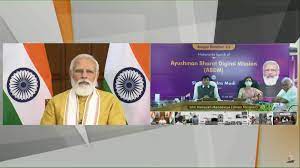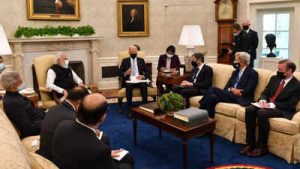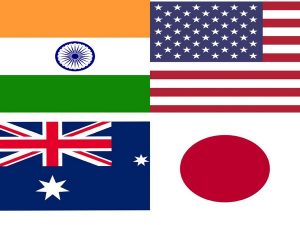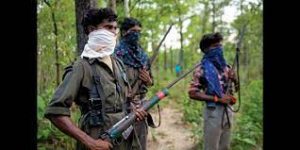Today Current Affairs: 28th September 2021 for UPSC IAS exams, State PSC exams, SSC CGL, State SSC, RRB, Railways, Banking Exam & IBPS, etc
Table of Contents
Ayushman Bharat Digital Mission:

Prime Minister Shri Narendra Modi will launch the Ayushman Bharat Digital Mission
- The pilot project of Ayushman Bharat Digital Mission had been announced by the Prime Minister from the ramparts of Red Fort on 15th August, 2020.
- Currently, Ayushman Bharat Digital Mission is being implemented in pilot phase in six Union Territories.
- The nation-wide rollout of Ayushman Bharat Digital Mission coincides with NHA celebrating the third anniversary of Ayushman Bharat Pradhan Mantri Jan Arogya Yojana (AB PM-JAY).
- Ayushman Bharat Digital Mission is based on the foundations laid down in the form of Jan Dhan, Aadhaar and Mobile (JAM) trinity and other digital initiatives of the government
- Ayushman Bharat Digital Mission will create a seamless online platform through the provision of a wide-range of data, information and infrastructure services, duly leveraging open, interoperable, standards-based digital systems while ensuring the security, confidentiality and privacy of health-related personal information.
- The key components of Ayushman Bharat Digital Mission include
- a health ID for every citizen that will also work as their health account, to which personal health records can be linked and viewed with the help of a mobile application;
- a Healthcare Professionals Registry (HPR) and Healthcare Facilities Registries (HFR) that will act as a repository of all healthcare providers across both modern and traditional systems of medicine.
- Ayushman Bharat Digital Mission Sandbox, created as a part of the Mission, will act as a framework for technology and product testing that will help organizations, including private players, intending to be a part of National Digital Health Ecosystem become a Health Information Provider or Health Information User.
Cyclone Gulab:

Cyclone ‘Gulab’ is likely to hit east coast of India. It is formed in the Bay of Bengal Region.
- Gulab name was suggested by Pakistan.
- Cyclones are formed over the oceanic water in the tropical region.
- In this region, the sunlight is highest which results in warming of land and water surface. Due to warming of the surface, the warm moist air over the ocean rises upwards following which cool air rushes in to fill the void, they too get warm and rise — the cycle continues.
- Wind always blows from high pressure to low pressure areas. High pressure areas are created in the cold region while low is created in the warm regions. Polar regions are high pressure areas as the amount of sunlight here is less than the tropical region. So, wind blows from polar regions to tropical regions.
- Then comes the Earth’s movement, which is west to east. The Earth’s rotation on its axis causes deflection of the wind (in the tropical region as the speed of spinning of Earth is higher compared to polar sides due to its spherical shape — blowing from both the polar regions. Wind coming from the Arctic is deflected to the right while Antarctic wind deflects to the left side.
- So, wind is already blowing in a direction. But when it reaches the warmer place, cool air starts getting attracted to the centre to fill the gap.
- So while moving to the centre, cool air keeps getting deflected resulting in circulation of wind movement — this process continues until the cyclone hits the land.
GI Tag To Assam’s Judima Wine Rice:

Judima, a home-made rice wine of Assam’s Dimasa tribe has become the first traditional brew in all of northeast to bag a Geographical Indication (GI) tag.
- This is the second product from the hill districts of Karbi Anglong and Dima Hasao to get GI tag.
- Earlier, Manipur’s most famous Hathei chilli and Tamenglong orange were awarded the GI Tag.
- Judima is a rice wine made from sticky rice (glutinous rice called Bora), which is steamed and mixed with traditional herbs called Thembra (Acacia pennata).
- The wine is a specialty of the Dimasa tribe of the state (Assam) and has a distinct sweet taste and takes around one week to prepare and it can be stored for years.
- There are around 14 recognized Plain Tribe communities, 15 Hills Tribe communities and 16 recognized Scheduled Caste communities in the state.
- The Bodos are the largest group, comprising almost half of the state’s tribal population. Other major ST groups include Mising, Karbi, Rabha, Kachari, Lalung and Dimasa.
Geographical Indication (GI):
- GI is an indication used to identify goods having special characteristics originating from a definite geographical territory.
- It is also a part of the World Trade Organisation’s Trade-Related Aspects of Intellectual Property Rights (TRIPS).
- GI tag in India is governed by Geographical Indications of Goods (Registration & Protection) Act, 1999. It is issued by the Geographical Indications Registry (Chennai).
- The registration of a geographical indication is valid for a period of 10 years.
- The GI protection in India leads to recognition of the product in other countries thus boosting exports.
National Mission On Cultural Mapping:

The National Mission on Cultural Mapping (NMCM) has been handed over to the Indira Gandhi National Centre for the Arts (IGNCA), which will start a trial run in 75 villages in October 2021.
- IGNCA was established in 1987 as an autonomous institution under the Ministry of Culture, as a centre for research, academic pursuit and dissemination in the field of the arts.
- IGNCA aims to complete mapping in 5,000 villages by the end of financial year 2021-2022.
- The Ministry of Culture had approved the NMCM in 2017 to build a comprehensive database of artists, art forms and other resources from organisations under the Ministry.
- It is aimed at addressing the necessities of preserving the threads of rich Indian Art and Cultural Heritage, converting vast and widespread cultural canvas of India into an objective Cultural Mapping while creating a strong “Cultural Vibrancy” throughout the nation.
- It encompasses data mapping, demography building, formalising the processes and bringing all cultural activities under one umbrella for better results.
- The work on creating a database for folk arts and mapping of heritage of villages would be carried out over five years (From 2017).
- Volunteers from the Nehru Yuva Kendra Sangathan, the National Service Scheme and students of sociology and social work would be deputed to collect such data from villages.
SAUBHAGYA Scheme:

The Pradhan Mantri Sahaj Bijli Har Ghar Yojana (SAUBHAGYA Scheme) has successfully completed four years of its implementation.
- 2.82 crore households have been electrified since its launch till 31st March, 2021.
- It was launched in 2017 to ensure electrification of all households in the country in rural as well as urban areas.
- Objectives:
- Achieving Universal Household Electrification in the country, through last mile connectivity.
- Providing access to electricity to all un-electrified households in rural areas and poor households in urban areas.
- Beneficiaries:
- They are identified using Socio Economic and Caste Census (SECC) 2011 data.
- However, un-electrified households not covered under the SECC data would also be provided electricity connections under the scheme by paying Rs 500.
Rajaji Tiger Reserve: Uttarakhand:

A Supreme Court-appointed committee has questioned relaxations given for the upgrade of a 4.7-km road (Laldhang-Chillarkhal road) in the buffer zone of Rajaji Tiger Reserve and sought replies from the Centre and Uttarakhand government.
- The relaxation for measurement of roads was approved by the National Board for Wildlife (NBWL). NBWL is the apex agency to clear projects in and around protected areas.
Core and Buffer Area of a Tiger Reserve:
- According to the Wild Life (Protection) Amendment Act of 2006, a tiger reserve must have a core or critical habitat and a buffer zone peripheral to it.
- While the critical habitat is supposed to be kept inviolate for conservation, a buffer zone is needed to ensure the integrity of the habitat with adequate space for dispersal of tigers. It is aimed at promoting co-existence between wildlife and human activity.
About Rajaji Tiger Reserve:
- Location: Haridwar (Uttarakhand), along the foothills of the Shivalik range. It is part of Rajaji National Park.
- Rajaji National Park was established in the year 1983 after amalgamating three sanctuaries in the Uttarakhand i.e. Rajaji, Motichur and Chila.
- It was named after the famous freedom fighter C. Rajgopalachari; popularly known as “Rajaji”.
- It was declared a Tiger Reserve in 2015 as the 48th tiger reserve of the country.
- Flora: Broadleaved deciduous forests, riverine vegetation, scrubland, grasslands and pine forests form the range of flora in this park.
Sal (Shorea robusta) is the characteristic dominant tree species. - Fauna: The reserve is home to more than 50 species of mammals including tiger, elephant, leopard, Himalayan black bear, sloth bear, jackal, hyena, spotted deer, sambhar, barking deer, nilgai, monkeys and over 300 species of birds.
- Rivers: The Ganga and Song rivers flow through this.
First Direct Detection Of Dark Energy:

An international team of researchers made the first direct detection of dark energy. The experiment named XENON1T, is the world’s most sensitive dark matter experiment and was operated deep underground at the INFN Laboratori Nazionali del Gran Sasso in Italy.
- Dark energy is the mysterious form of energy that makes up about 68% of the universe, and has intrigued physicists and astronomers for decades.
About the Experiment:
- The XENON1T is a dark matter research project, operated at the Italian Gran Sasso National Laboratory.
- It is a deep underground research facility featuring increasingly ambitious experiments aiming to detect dark matter particles.
- The experiments aim to detect particles in the form of Weakly Interacting Massive Particles (WIMPs) by looking for rare interactions via nuclear recoils in a liquid xenon target chamber.
Other Dark Matter and Energy Experiments:
- LUX-Zeplin – a next generation dark matter experiment located at the Sanford Underground Research Facility, US.
- PandaX-xT – project at China Jinping Underground Laboratory.
Dark Matter And Dark Energy:
- While dark matter attracts and holds galaxies together, dark energy repels and causes the expansion of our universe.
- Despite both components being invisible, a lot more is known about dark matter, since its existence was suggested as early as the 1920s, while dark energy wasn’t discovered until 1998.
About Dark Energy:
- The Big Bang occurred nearly 15 billion years ago and expanded. Earlier, astronomers believed that eventually the expansion of the Universe will slow down because of gravity and it will recollapse.
- However, data from the Hubble Telescope suggested that the Universe’s expansion is accelerating.
- The astronomers theorize that the faster expansion rate is due to a mysterious, dark force or energy that is pulling galaxies apart.
India-US Bilateral Meet:

The Indian Prime Minister met the newly elected US President for their first bilateral meeting in the US.
- Both leaders discussed a wide range of priority issues, including combating Covid-19, climate change, and economic cooperation.
- Earlier, the US Secretary of State, in his visit to India, mentioned that actions by India and the US will shape the 21st century.
Highlights of the Meet:
- Discussions to further cement the Indo-US strategic partnership and discussed global issues of common interest, including threats to democracy, Afghanistan and the Indo-Pacific.
- Discussed Pakistan’s role in Afghanistan as one of the key challenges, and there was a sense that it needs more “careful monitoring”.
- Both sides denounced any use of terrorist proxies and emphasised the importance of denying the logistical, financial or military support to terrorist groups, which could be used to plan, or launch terror attacks.
- They called on the Taliban to adhere to these and all of its commitments under Resolution 2593.
- The US Government, companies based in the USA and the Indian diaspora were very helpful when India was fighting a tough wave of Covid-19 infections.
- India will resume export of surplus Covid-19 vaccines in the fourth quarter of 2021 under the Vaccine Maitri programme and to meet its commitment to the COVAX global pool.
- India raised several issues involving the Indian community in the US, including access for Indian professionals there and H-1B visas.
First in-Person Meeting Of Quad Countries:

The first in-person meeting of Quad leaders was hosted by the US. Issues like climate change, Covid-19 pandemic and challenges in the Indo Pacific, amidst China’s growing military presence in the strategic region, were discussed in the meeting.
- In November 2017, India, Japan, the US and Australia gave shape to the long-pending proposal of setting up the Quad to develop a new strategy to keep the critical sea routes in the Indo-Pacific free of any influence.
- China claims nearly all of the disputed South China Sea, though Taiwan, the Philippines, Brunei, Malaysia and Vietnam all claim parts of it.
- The South China Sea is an arm of the Western Pacific Ocean.
- In 2020, the trilateral India-US-Japan Malabar naval exercises expanded to include Australia, marking the first official grouping of the Quad since its resurgence in 2017.
- Further, it is the first joint military exercises among the four countries in over a decade.
- In March 2021, the Quad leaders met virtually and later released a joint statement titled ‘The Spirit of the Quad,’ which outlined the group’s approach and objectives.
- Further, just before this meeting, the US has announced a new trilateral security partnership for the Indo-Pacific, between Australia, the UK and the US (AUKUS).
Major Highlights of the Quad Summit:
- Discussed Afghanistan and agreed to deepen their cooperation in South Asia.
- Quad Vaccine Initiative: Under this, the Quad countries have pledged to donate more than 1.2 billion Coid-19 vaccine doses globally, in addition to the doses financed through Covax.
- Building Back Better Health Security: Supported the call for a “global pandemic radar” to improve viral genomic surveillance and expand the WHO Global Influenza Surveillance and Response System (GISRS).
- Quad Infrastructure Coordination Group: The G7 grouping has recently announced the Build Back Better World (B3W) initiative.
- Based on similar lines, the Quad will establish high-quality infrastructure and will share expertise, capacity, and influence in the region and identify new opportunities to meet the needs there.
- Tackling Climate Change: In this context, Quad countries has envisaged to establish:
- Green-Shipping Network for deployment of green-port infrastructure.
- Clean-Hydrogen Partnership to strengthen and reduce costs across all elements of the clean-hydrogen technology, leveraging existing bilateral and multilateral hydrogen initiatives in other fora.
- Climate Adaptation, Resilience, and Preparedness for increasing the Indo-Pacific region’s resilience to climate change by improving critical climate information-sharing and disaster-resilient infrastructure.
- Apart from this, Quad countries intend to update or communicate ambitious NDCs (Nationally Determined Contributions) by COP26.
- The Quad Fellowship: The Fellowship will sponsor 100 students per year – 25 from each Quad country – to pursue masters and doctoral degrees at leading STEM (Science, Technology Engineering, and Mathematics (STEM) programmes) graduate universities in the United States.
- Semiconductor Supply Chain Initiative: It will be a joint initiative to map capacity, identify vulnerabilities, and bolster supply-chain security for semiconductors and their vital components.
- This initiative will help ensure Quad partners support a diverse and competitive market that produces the secure critical technologies essential for digital economies globally.
- Critical and Emerging Technologies: The announcement of launch of a 5G deployment and calls for monitoring trends in advanced biotechnologies, including synthetic biology, genome sequencing, and biomanufacturing.
- Quad Senior Cyber Group: This group will make shared cyber standards; development of secure software; building workforce and talent; and promoting the scalability and cybersecurity of secure and trustworthy digital infrastructure.
- Satellite Data Sharing: The Quad will begin space cooperation for the first time with a new working group.
- In pursuance of this, Quad countries will start discussions to exchange Earth observation satellite data and analysis on climate-change risks and the sustainable use of oceans and marine resources.
Maoists:

The geographical influence of Maoists has contracted to only 41 districts in the country, a sharp reduction from 96 such districts in 10 States in 2010, according to data provided by the Ministry of Home Affairs (MHA) to Chief Ministers and other officials at a meeting held.
- These miscreants have been pushed to a few pockets with only 25 districts accounting for 85% of the LWE (Left Wing Extremism) violence in the country.
- Union Home Minister Amit Shah chaired the meeting to review the security and other developmental aspects in the LWE-hit States.
- Addressing the meeting, Jharkhand Chief Minister Hemant Soren accused the Centre of slashing the number of LWE-affected districts in the State that could avail ₹33 crore under the Special Central Assistance (SCA) and Security Related Expenditure (SRA) scheme for infrastructure-related projects.
- According to the ministry, there has been a gradual decline in the number of LWE incidents in the last decade. The incidents have reduced from 2,258 in 2009 to 349 incidents till August 31 this year. The number of deaths reduced from 908 to 110 during the same period.




